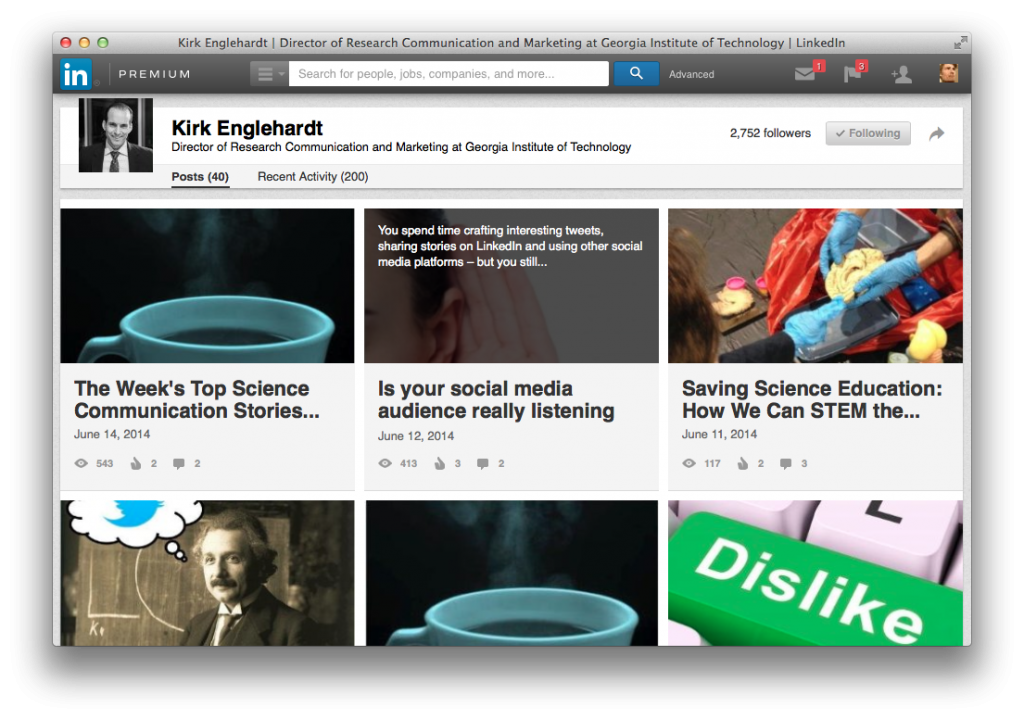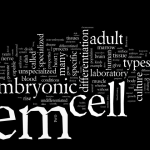LinkedIn champion publishes weekly link tips about science communication
Interested in current topics in science communication? Then follow The Week’s Top Science Communication Stories – a weekly link list published on LinkedIn. The editor, Kirk Englehardt at Georgia Tech, can be described as a LinkedIn champion who demonstrates the true potential of this media platform.
Kirk Englehardt’s link lists are still only published on LinkedIn, but as a courtesy to the followers of Scientia Crastina we will make them easy to track from our Links page. Curious as always, we asked Kirk some questions – both about the link lists and how to use LinkedIn.
How do you proceed to collect The Week’s Top Science Communication Stories?
I am committed to continuously learning more about science communication, and there is an endless supply of outstanding material being written on the topic. I follow many individual blogs, use Flipboard, subscribe to many eNewsletters and monitor a number of social media channels. I share what I find in real-time on Twitter (@kirkenglehardt) – and in a number of other places online.
I have also developed relationships with many of the people I consider to be leaders in the field of science communication. I follow them closely and enjoy sharing their great material with others. Each week’s Top Science Communication Stories post on LinkedIn receives nearly 500 views. And I’ve been told some people actually look forward to reading it over breakfast on Saturday morning!
How come you are so active on LinkedIn?
I have been on LinkedIn for many years. It’s only recently that I started to actively use the service to share science communication information. This was largely due to the fact that LinkedIn offered many regular users – like me – the ability to share long-form posts.
I now use it as a blogging platform where I also share many of my own science communication-themed posts. It’s an active network, which is nice. People are not afraid to share their comments, many of which provide ideas for brand new posts I can write.
I’m still not sure of LinkedIn’s value as a science communication platform though. A number of us have been pushing for the addition of a ‘channel’ dedicated to science – which would open the door for much more scientific sharing and collaboration on LinkedIn.
What advice do you have for early career scientists who want to use LinkedIn in an effective way.
1. The first step is to set up a profile on LinkedIn and start developing a solid network of connections. The service makes this very easy, and even offers recommendations based on what you include in your profile.
2. Next, you should search LinkedIn’s groups for those that match your interests. This will allow you to follow posts from, and engage in discussions with, people with whom you share similar interests.
3. As you become more familiar with the service you may also want to subscribe to different topic channels, establish your own groups or start blogging (once long-form blogging is rolled out to all users.) I have made many wonderful new connections through LinkedIn. I think – in time – it will become an even better tool for scientific collaboration and sharing.
Crastina will soon offer tutorials that take a closer look on the pieces of advice above, guiding you through the procedures step by step.
Kirk Englehardt about his work at Georgia Tech Institute Communications Today, I serve as the strategic leader for all communication and marketing activities at the university, supporting our entire $700 million research enterprise. I am currently developing Georgia Tech’s first strategic communications and marketing plan for research. I am also responsible for creating a shared vision about how Georgia Tech research will be communicated by all of the university’s departments and units. We have three goals for our research communications activities: ”I am Georgia Tech’s first Director of Research Communication. It’s a unique position that reports to both our Executive Vice President for Research and our Vice President for Institute Communications. I’d previously spent seven years directing communication for the Georgia Tech Research Institute, and during that time I created an integrated communications and marketing program that helped grow it’s research funding from around $120 million to nearly $300 million.
”I am Georgia Tech’s first Director of Research Communication. It’s a unique position that reports to both our Executive Vice President for Research and our Vice President for Institute Communications. I’d previously spent seven years directing communication for the Georgia Tech Research Institute, and during that time I created an integrated communications and marketing program that helped grow it’s research funding from around $120 million to nearly $300 million.
- Claire Price of Crastina receives outreach award from Royal Society of Biology - October 25, 2020
- Agile Science student project at Brussels Engineering School ECAM: “We can’t wait to try it again!” - August 28, 2020
- Create an infographic in the Lifeology SciArt Infographic Challenge - June 16, 2020
- Adam Ruben – The scientist that teaches undergraduate students comedy - March 27, 2020
- Sam Gregson, Bad Boy of Science: “Comedy helps to bridge the gap” - March 10, 2020
- The Coolest Science Merchandise of 2019 - December 16, 2019
- Science Media Centre (UK) offers guide on dealing with online harassment in academia - November 26, 2019
- Agile project management taught to students and researchers at Karolinska Institutet - September 20, 2019
- Stefan Jansson: Improve your credibility! (Crastina Column, September 2019) - September 6, 2019
- The People’s Poet: Silke Kramprich, tech communicator - August 31, 2019





Trackbacks & Pingbacks
[…] LinkedIn champion publishes weekly link tips about science communication […]
Leave a Reply
Want to join the discussion?Feel free to contribute!